Environmental sensing has become increasingly important in various industries, from weather forecasting to indoor navigation and consumer electronics. At the forefront of this technological advancement are sensors like the BMP280 and BMP180, which excel in measuring temperature and barometric pressure with exceptional precision and reliability.
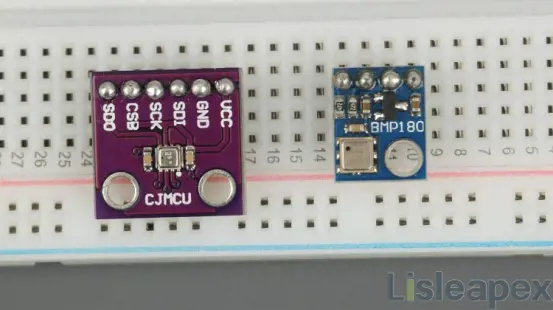
These sensors, renowned for their compact size, versatile compatibility, and low power consumption, have revolutionized the way we gather environmental data for a wide range of applications. In this article, we delve into the capabilities and differences between the BMP280 and BMP180 sensors, exploring their specifications, features, and advantages in detail.
What is BMP280
The BMP280 is a highly versatile environmental sensor renowned for its precision and reliability in measuring temperature and barometric pressure. Its compact size and compatibility with both I2C and SPI communication protocols make it a preferred choice for a wide range of applications, from weather forecasting and altitude sensing to indoor and outdoor navigation systems. With an operating temperature range spanning from -40°C to +85°C and the ability to deliver accurate measurements in various environmental conditions, the BMP280 excels in providing consistent performance across diverse settings.
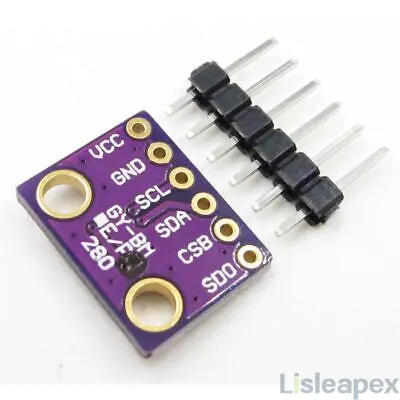
Additionally, its low power consumption and high precision measurements ensure efficient and accurate data acquisition, making it an indispensable component in applications where reliability and energy efficiency are paramount. Whether utilized in consumer electronics, healthcare devices, or leisure gadgets, the BMP280 continues to prove its value as a reliable and versatile sensing solution.
1) BMP280 Pinout
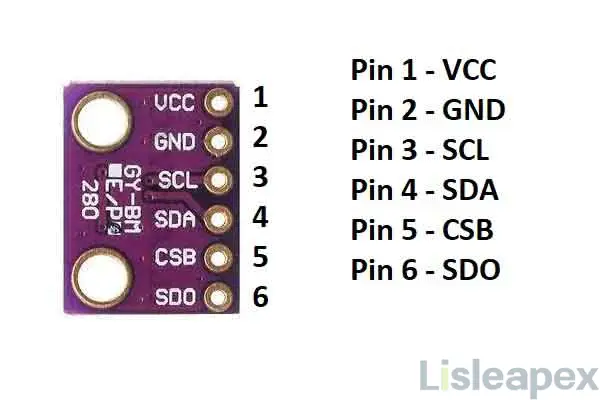
Pin configuration
|
Pin Number |
Function |
Description |
|
1 |
VCC (Power) |
Supplies power to the BMP280 sensor. Connect to a 3.3V or 5V power source. |
|
2 |
GND (Ground) |
Ground connection for the BMP280 sensor. Connect to the ground terminal of the power supply. |
|
3 |
SCL (Serial Clock) |
Clock input for I2C communication. Synchronizes data transfer between the sensor and microcontroller. |
|
4 |
SDA (Serial Data) |
Data input/output for I2C communication. Bi-directional data transfer between the sensor and microcontroller. |
|
5 |
CSB (Chip Select) |
Chip select input for SPI communication. Used to select the BMP280 sensor when multiple devices are connected on the bus. |
|
6 |
SDO (Serial Data Out) |
Data output for SPI communication. Transmits data from the sensor to the microcontroller during SPI communication. |
2) BMP280 Specifications
|
Specification |
Details |
|
Chip |
BMP280 |
|
Digital Interfaces |
I²C (up to 3.4 MHz) and SPI (3 and 4 wire, up to 10 MHz) |
|
Peak Current |
1.12mA |
|
Power Supply |
3V/3.3V DC |
|
Temperature Range |
-40°C to +85°C |
|
Air Pressure Range |
300-1100hPa (equivalent to +9000…-500m above sea level) |
|
Sample Rate |
1Hz |
|
Current Consumption |
2.7µA @ 1 Hz sampling rate |
3) Features of BMP280
- Environmental Sensing: The BMP280 sensor is designed to accurately measure temperature and barometric pressure, making it ideal for a wide range of weather sensing applications.
- Next Generation Upgrade: As the successor to the BMP085/BMP180/BMP183 sensors, the BMP280 offers improved performance and enhanced features.
- Versatile Compatibility: This sensor supports both I2C and SPI communication protocols, providing flexibility in integration with various microcontroller platforms.
- Precision Measurements: With ±1 hPa absolute accuracy for barometric pressure and ±1.0°C accuracy for temperature, the BMP280 delivers precise environmental data.
- Altimeter Functionality: Due to its accurate pressure measurements and the correlation between pressure and altitude, the BMP280 can function as an altimeter with ±1 meter accuracy.
- Pin Pitch: The module features a pin pitch of 2.54mm, ensuring compatibility with standard breadboard and development board layouts.
- Compact Size: With dimensions of 11.5mm by 15mm, the BMP280 module offers a compact form factor suitable for space-constrained applications.
4) Application & Uses
- GPS Navigation Enhancement
- Indoor Navigation
- Outdoor Navigation and Leisure Activities
- Weather Forecasting
- Vertical Velocity Indication
- Healthcare Applications
- Consumer Electronics
- Flying Toys
5) Functional Block Diagram
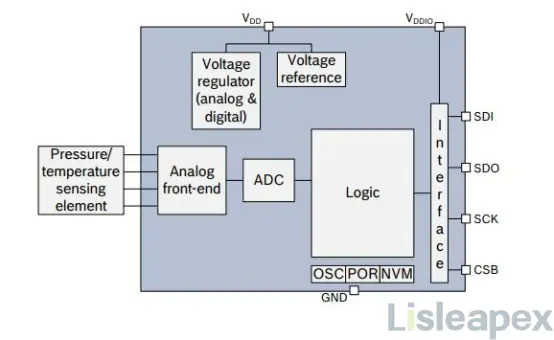
6) Advantages of BMP280
High Precision Measurements: The BMP280 sensor offers precise temperature measurements with an accuracy of ±1.0°C and accurate barometric pressure readings with a ±1 hPa accuracy, ensuring reliable and consistent data for various applications such as weather monitoring and altitude sensing.
Low Power Consumption: With a peak current of only 1.12mA, the BMP280 sensor consumes minimal power, making it ideal for battery-powered devices and applications where power efficiency is crucial, such as portable weather stations or wearable devices.
Wide Operating Temperature Range: Operating reliably in temperatures ranging from -40°C to +85°C, the BMP280 sensor provides consistent performance across various environmental conditions, making it suitable for both indoor and outdoor applications, including automotive, aerospace, and industrial environments.
Versatile Compatibility: Supporting both I2C and SPI communication interfaces, the BMP280 sensor offers versatile compatibility with a wide range of microcontrollers and development platforms, simplifying integration into existing systems and enabling seamless communication with other devices.
Compact Form Factor: With a small module size of 11.5mm by 15mm and a standard pin pitch of 2.54mm, the BMP280 sensor is compact and easy to integrate into space-constrained designs, such as handheld devices, drones, or IoT sensors, without sacrificing performance or accuracy.
What is BMP180

1) BMP180 Pinout
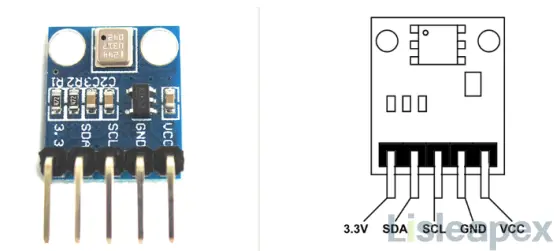
Pin configuration
The BMP180 sensor is available in two module configurations: a Five-pin module and a Four-pin module. While both modules share the same functionality, the Five-pin module includes an additional +3.3V pin absent in the Four-pin module. The pins VCC and GND are utilized for power supply and ground connection respectively, while SDA and SCL are dedicated to the serial data and serial clock signals for I2C communication. Additionally, the +3.3V pin serves as an alternative power source when +5V is not available.
|
Pin Name |
Description |
|
VCC |
Connected to +5V power supply |
|
GND |
Connected to ground |
|
SDA |
Serial Data pin for I2C communication |
|
SCL |
Serial Clock pin for I2C communication |
|
3.3V |
Alternative power source if +5V is absent |
2) BMP180 Specifications
|
Specification |
Details |
|
Input Voltage (Vin) |
3 to 5VDC |
|
Logic Level |
3 to 5V compliant |
|
Pressure Sensing Range |
300-1100 hPa (9000m to -500m above sea level) |
|
Resolution |
Up to 0.03hPa / 0.25m |
|
Operational Range |
-40 to +85°C |
|
Temperature Accuracy |
±2°C |
|
Communication Protocol |
I2C |
|
I2C Address |
7-bit address: 0x77 |
3) Features of BMP180
- Wide Voltage Range: Operates efficiently within a wide voltage range from 1.8V to 3.6V, with 3.3V being the recommended voltage for optimal performance.
- Low Power Consumption: Demonstrates minimal electricity demand, making it suitable for battery-powered applications where energy efficiency is crucial.
- Fast Pressure Conversion: Completes pressure conversions rapidly within 5 milliseconds, ensuring real-time data acquisition and responsiveness.
- Extended Pressure Range: Offers a wide measurement range from 300 to over 1,000 hectoPascals, catering to various altitude and environmental conditions.
- High Accuracy: Provides precise pressure readings with minimal deviation of ±0.15hPa, ensuring reliable and accurate data for critical applications such as altitude sensing and weather monitoring.
4) Application & Uses
Weather Forecasting: Utilize BMP180 sensors to determine and forecast weather patterns, providing valuable data for meteorological analysis and prediction.
Agricultural Planning: Aid in determining the optimal timing for crop cultivation by analyzing atmospheric pressure data, contributing to better crop management practices and yield optimization.
Indoor Navigation: Enable indoor navigation systems, particularly in areas with varying altitudes, offering enhanced guidance and positioning capabilities for users in complex indoor environments.
GPS and Sports Devices: Improve the accuracy and performance of GPS and sports devices by integrating BMP180 sensors, empowering users with precise barometric and altimetric data for navigation, tracking, and performance analysis.
Vertical Velocity Indication: Provide real-time indication of vertical velocity, supporting applications such as aviation, drone flying, and parachute sports where precise altitude control and monitoring are critical.
Aerial Activity Guidance: Guide aerial activities such as drone flying by offering altitude and atmospheric pressure data, ensuring safe and efficient operation in varying environmental conditions.
Pressure-Dependent Equipment Optimization: Enhance the productivity and efficiency of pressure-dependent machinery and equipment by leveraging BMP180 sensors to monitor and regulate pressure levels, optimizing performance and reducing downtime.
5)Advantages of BMP180
High Precision Measurements: The BMP180 sensor offers precise measurements of both temperature and barometric pressure, ensuring accurate and reliable data for various applications such as weather monitoring and altitude sensing.
Wide Operating Voltage Range: Operating efficiently within a wide voltage range from 1.8V to 3.6V, the BMP180 sensor is suitable for a variety of electronic systems and can adapt to different power supply configurations.
Low Power Consumption: With minimal electricity demand, the BMP180 sensor is ideal for battery-powered devices and applications where energy efficiency is crucial, ensuring extended operational lifetime.
Fast Response Time: The BMP180 sensor features rapid pressure conversion within 5 milliseconds, providing real-time data acquisition and responsiveness for time-sensitive applications.
Extended Pressure Range: Covering a wide pressure range from 300 to over 1,000 hectoPascals, the BMP180 sensor caters to diverse altitude and environmental conditions, making it suitable for various outdoor and indoor applications.
BMP280 vs BMP180: Differences between BMP280 vs BMP180
The BMP280 and BMP180 are both highly versatile environmental sensors renowned for their precision and reliability in measuring temperature and barometric pressure. They share similarities in their compact size, compatibility with both I2C and SPI communication protocols, and wide operating temperature range spanning from -40°C to +85°C. Both sensors offer accurate measurements of temperature and barometric pressure, making them ideal for various applications such as weather monitoring, altitude sensing, and navigation systems. Additionally, they feature low power consumption, making them suitable for battery-powered devices where energy efficiency is crucial.
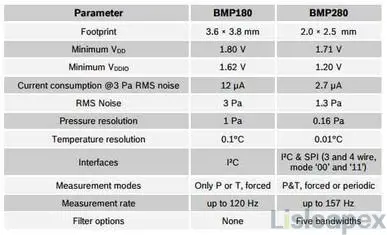
|
Feature |
BMP280 |
BMP180 |
|
Power Supply Voltage |
3V/3.3V DC |
1.8V to 3.6V |
|
Digital Interfaces |
I²C (up to 3.4 MHz) and SPI (up to 10 MHz) |
I²C (up to 3.4 MHz) |
|
Peak Current |
1.12mA |
Not specified |
|
Temperature Range |
-40°C to +85°C |
-40°C to +85°C |
|
Pressure Sensing Range |
300-1100 hPa (equivalent to +9000…-500m) |
300-1100 hPa (equivalent to +9000…-500m) |
|
Resolution |
Not specified |
Up to 0.03hPa / 0.25m |
|
Temperature Accuracy |
±1.0°C |
±2°C |
|
Sample Rate |
1Hz |
Not specified |
|
Current Consumption |
2.7µA @ 1 Hz sampling rate |
Not specified |
|
Additional Features |
Altimeter functionality, enhanced accuracy |
EEPROM for data storage, extended pressure |
Manufacturer
BMP280 and BMP180 are sensor products developed and manufactured by Bosch Sensortec. Bosch Sensortec is a subsidiary of the German Bosch Group, specializing in the development and production of advanced sensor solutions. As a leading technology company, Bosch Sensortec has extensive experience and expertise in the field of sensors, actively driving the development and innovation of sensor technology.
Bosch Sensortec's sensor products cover a wide range of application areas, including but not limited to smartphones, wearable devices, smart homes, automotive, industrial automation, and the Internet of Things (IoT). The company is committed to providing high-performance, high-precision, and highly reliable sensor solutions to meet customers' needs for data acquisition, environmental monitoring, and position sensing.
As part of the Bosch Group, Bosch Sensortec inherits Bosch's rich resources in technology and manufacturing. Through continuous innovation and research and development, Bosch Sensortec constantly pushes the advancement of sensor technology. Leveraging its global production network and rigorous quality control system, Bosch Sensortec ensures the stability and consistency of its products worldwide, providing customers with excellent user experience and enduring performance.
Datasheet PDF
Conclusion
In conclusion, the BMP280 and BMP180 sensors stand as indispensable tools in the realm of environmental sensing, offering unparalleled precision, reliability, and versatility. Whether deployed in weather stations, navigation systems, or consumer gadgets, these sensors provide crucial data for informed decision-making and enhanced performance. As technology continues to evolve, these sensors pave the way for further innovations in environmental monitoring and beyond, driving progress in various industries and enriching our understanding of the world around us.
FAQ
-
Can the BMP280 and BMP180 be used interchangeably in the same design?
Yes, in many cases, the BMP280 and BMP180 can be used interchangeably in the same design with minimal changes to the firmware and calibration parameters. However, it's essential to verify compatibility and adjust any configuration settings accordingly.
-
Do the BMP280 and BMP180 require calibration?
Both sensors may require calibration to achieve optimal accuracy, especially in critical applications. Calibration involves compensating for sensor drift and environmental factors to ensure accurate measurements over time.
-
Can the BMP280 and BMP180 be used in weather monitoring applications?
Yes, both sensors are commonly used in weather monitoring applications to measure temperature, pressure, and altitude. The BMP280's higher accuracy and additional features may make it preferable for certain weather monitoring applications.
-
Which sensor is more commonly used in consumer electronics devices?
The BMP280 is more commonly used in consumer electronics devices due to its higher accuracy, wider measurement range, and additional features, making it suitable for various applications such as smartphones, wearables, and IoT devices.
-
Which sensor is more cost-effective?
The BMP180 is generally more cost-effective compared to the BMP280, but the price difference may vary depending on factors such as volume discounts, supplier pricing, and application requirements.
Stay updated with Lisleapex by signing up for the newsletter


 Congratulations On Your Successful Submission
Congratulations On Your Successful Submission
 Submission Failure
Submission Failure
